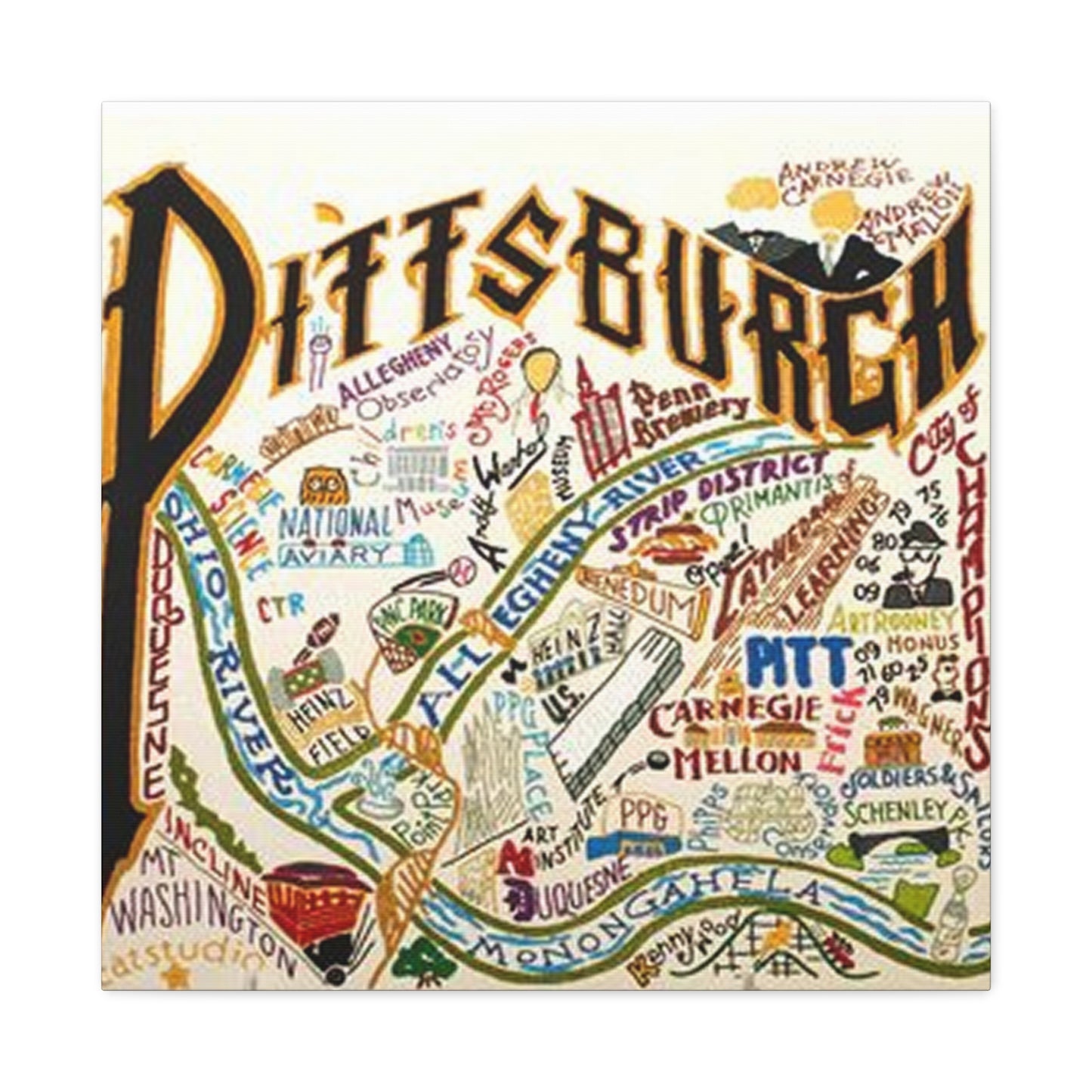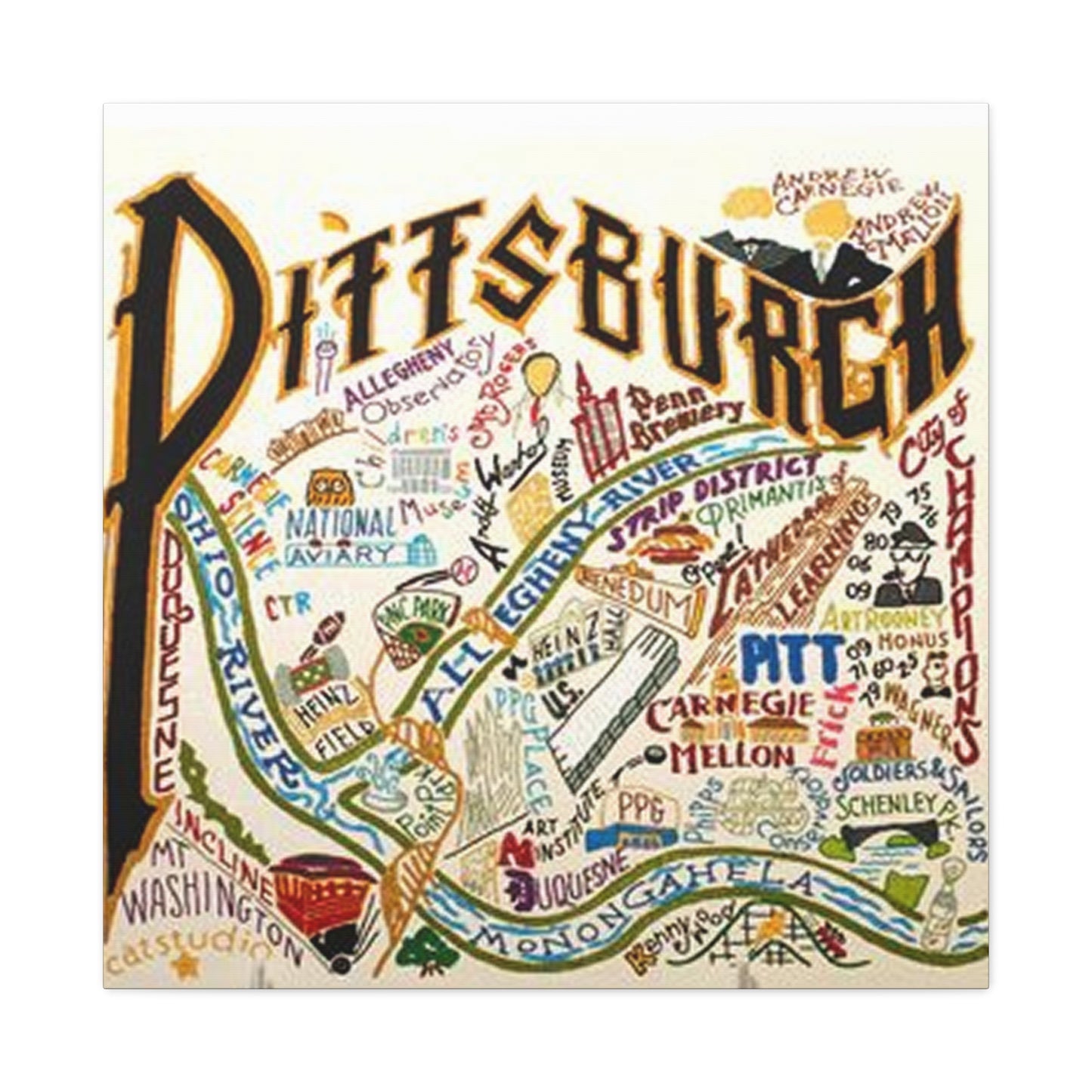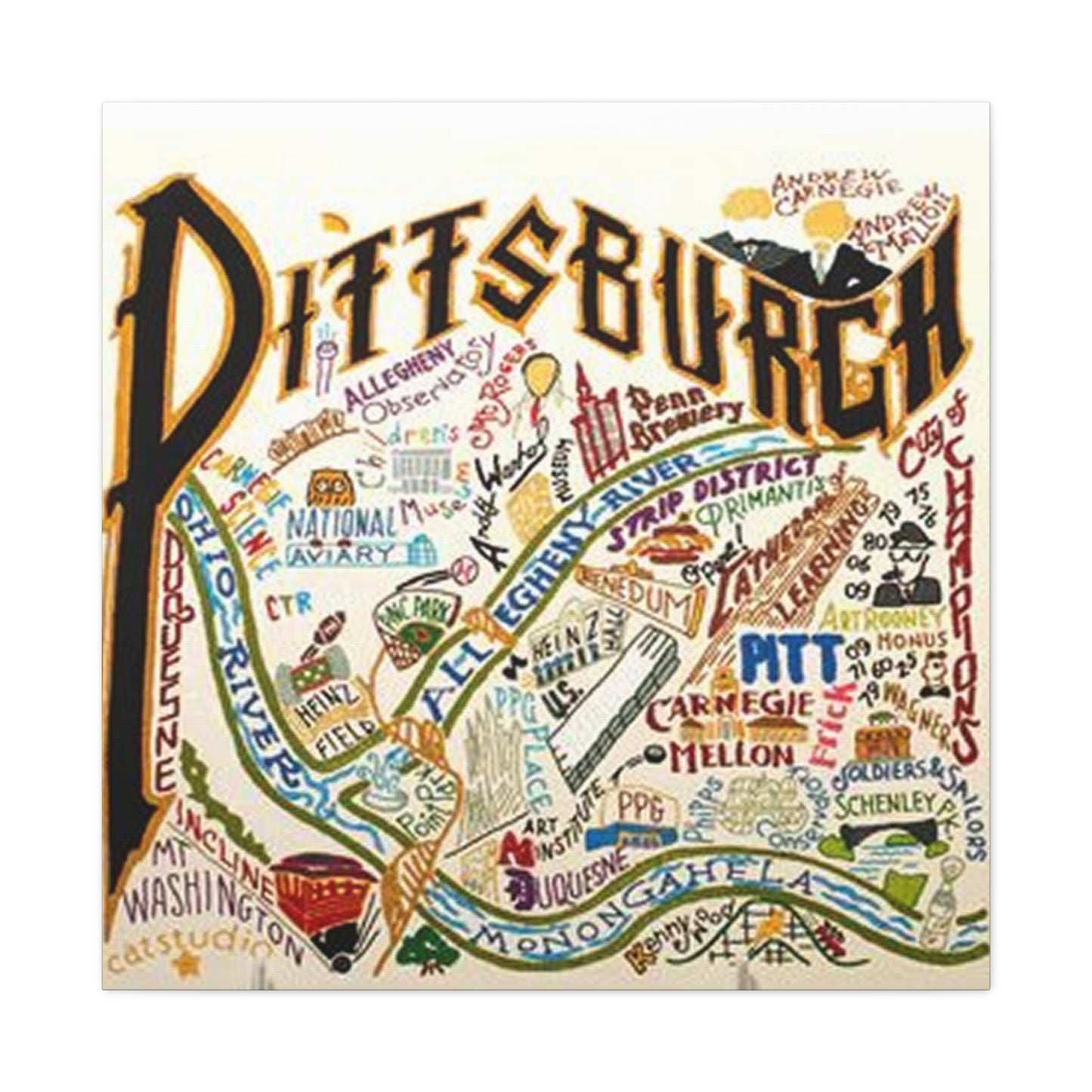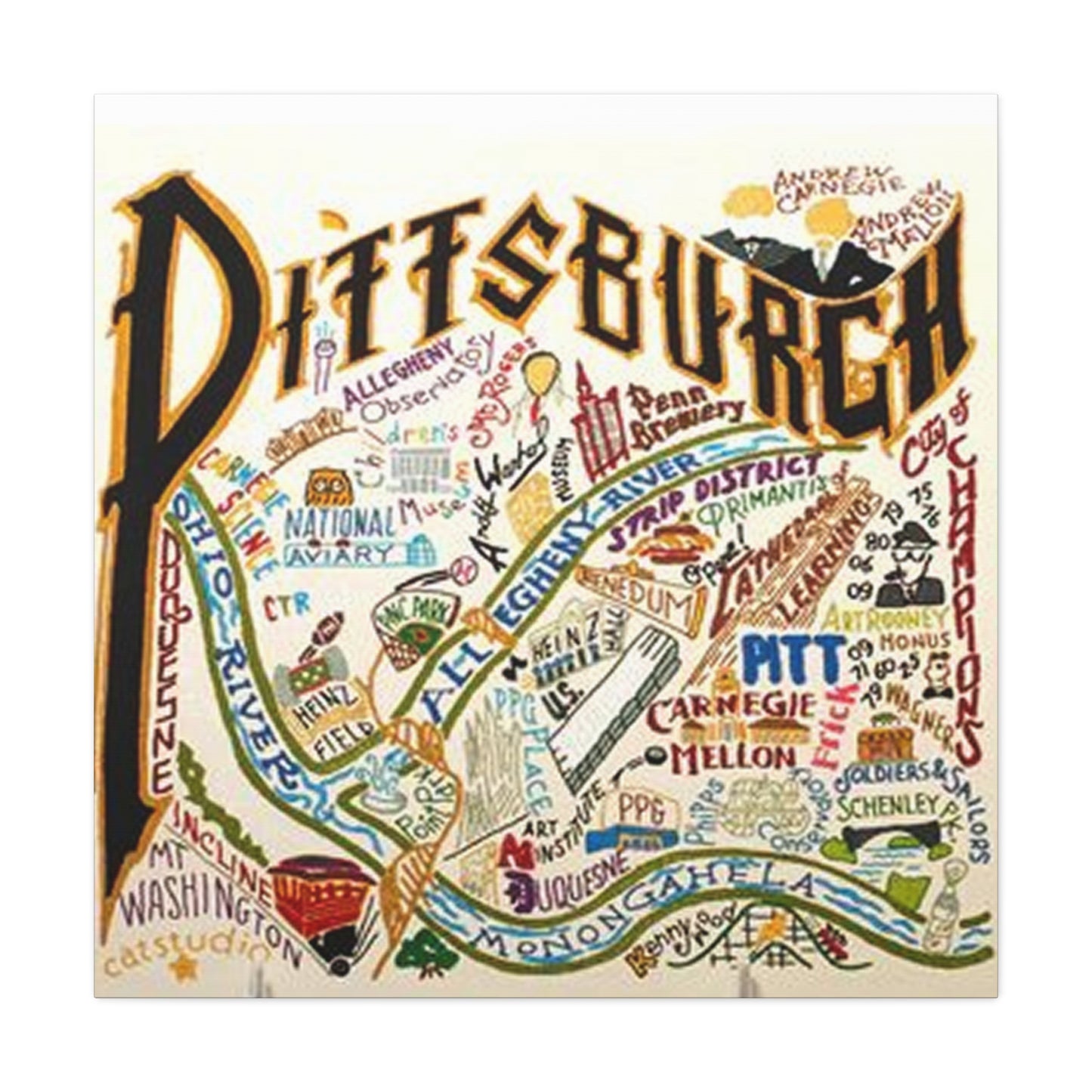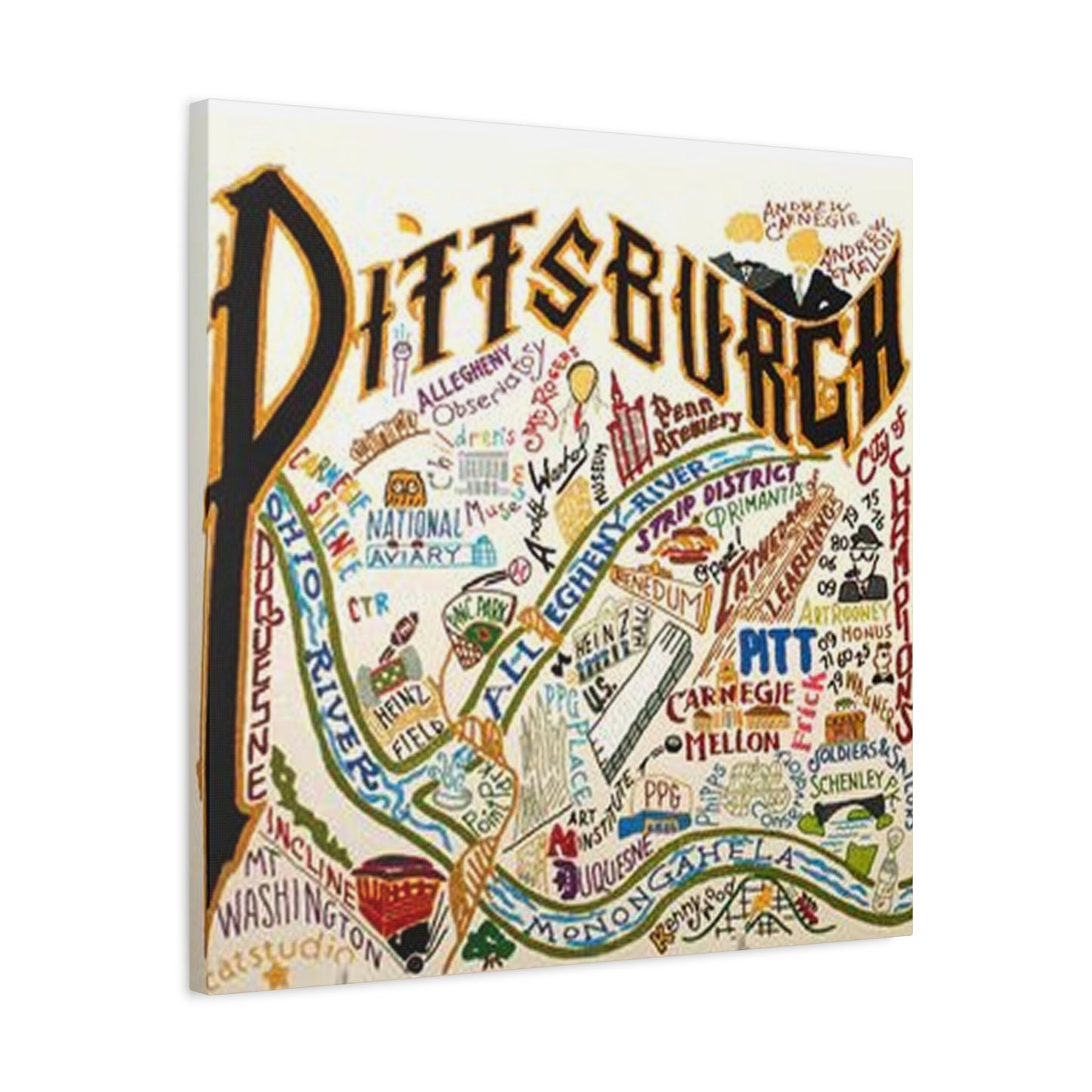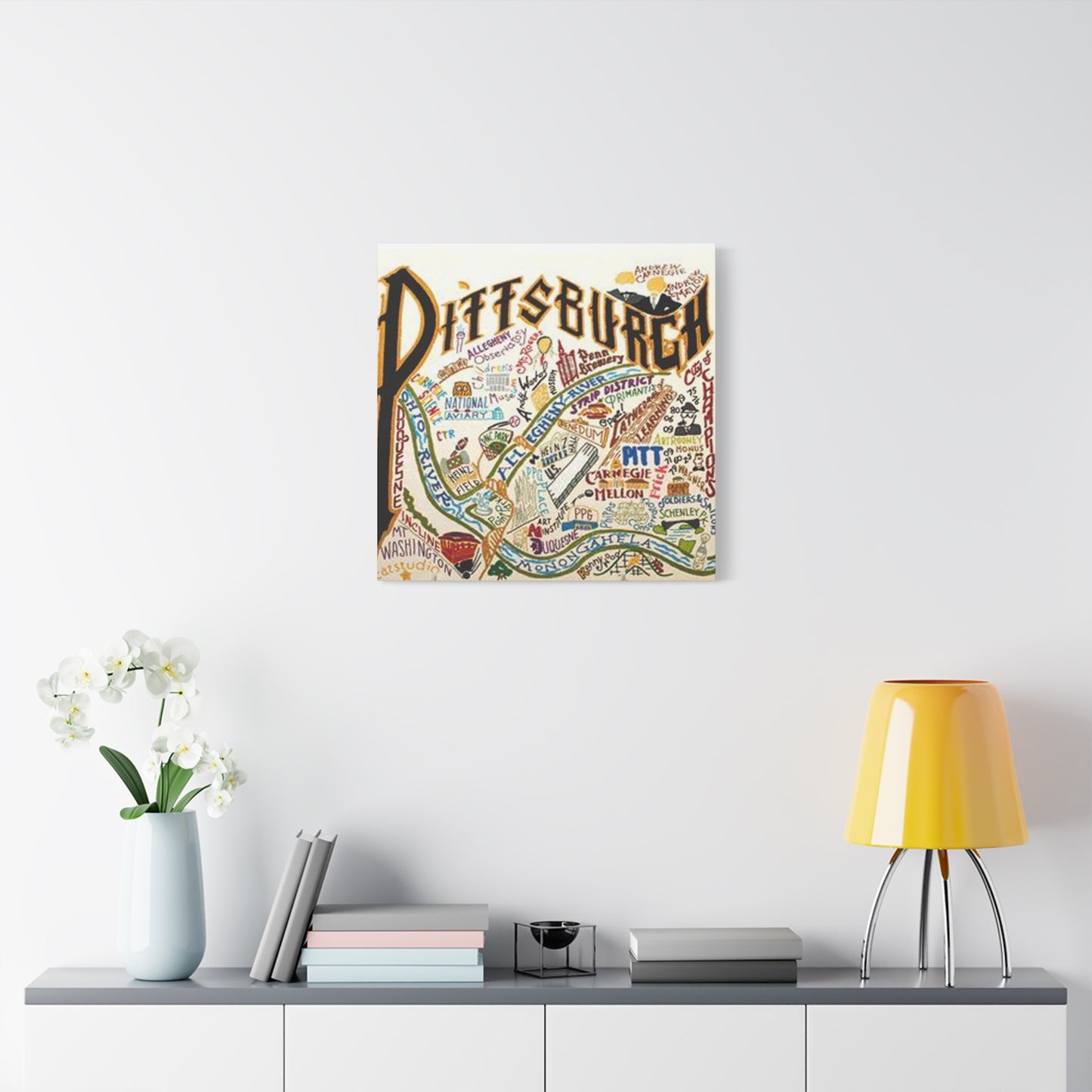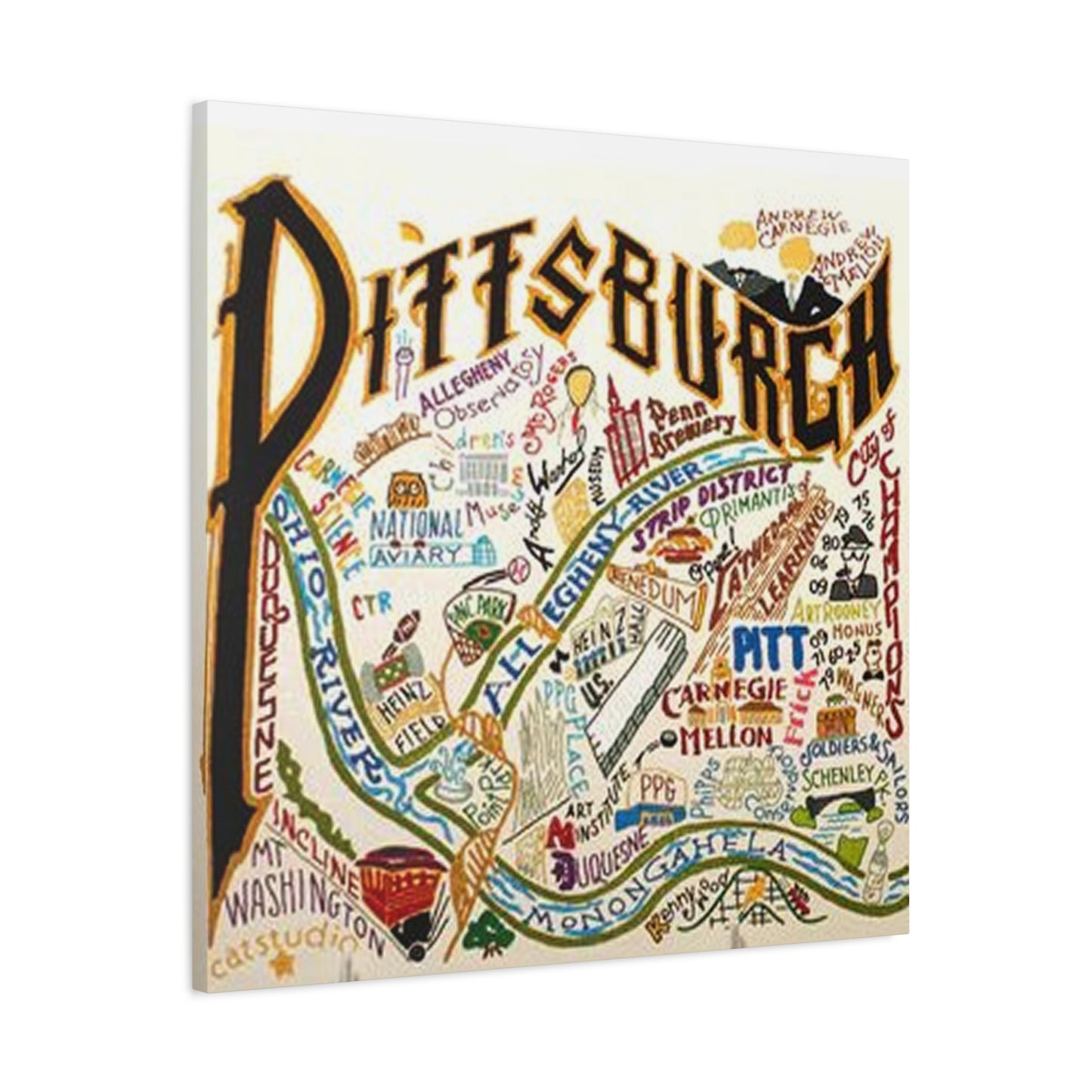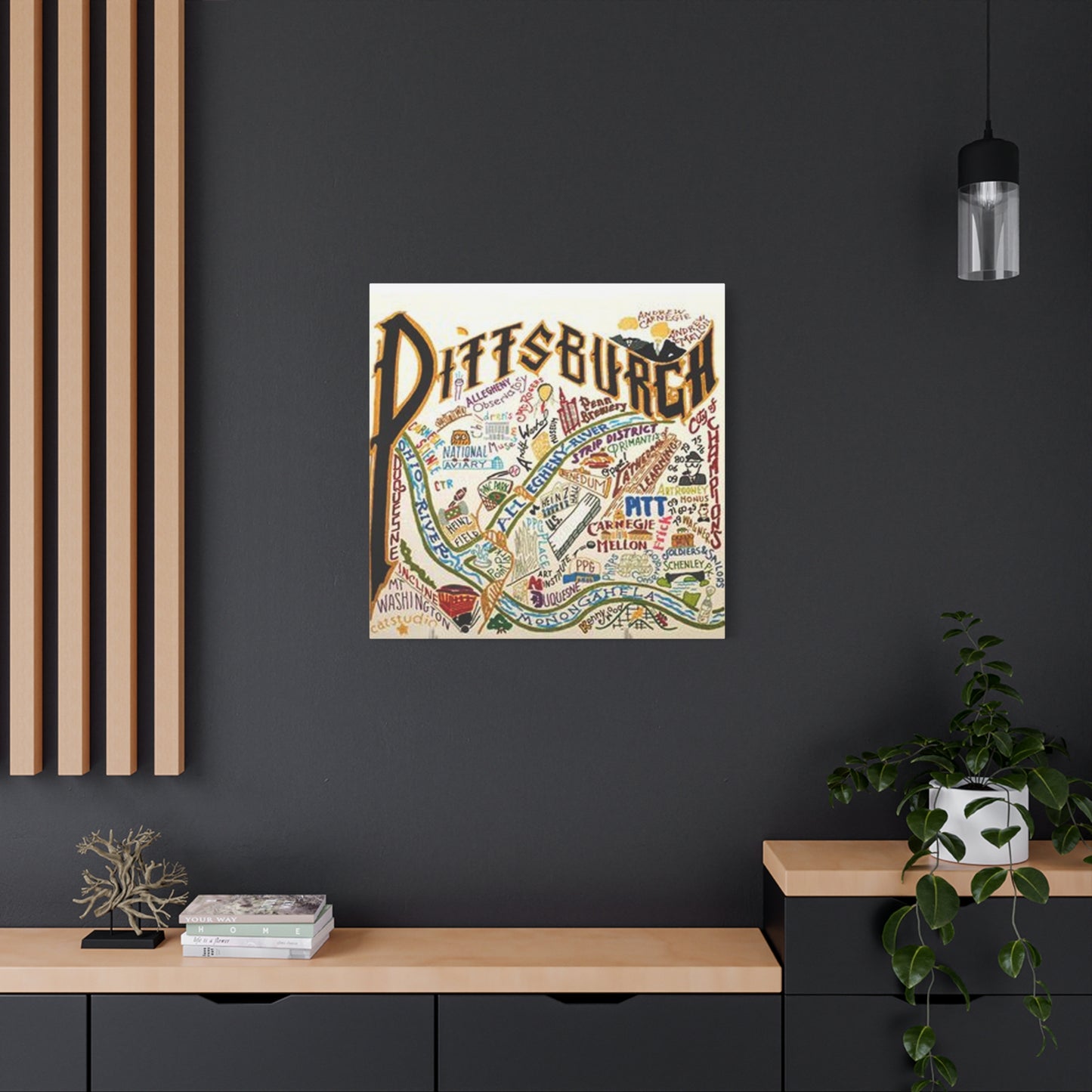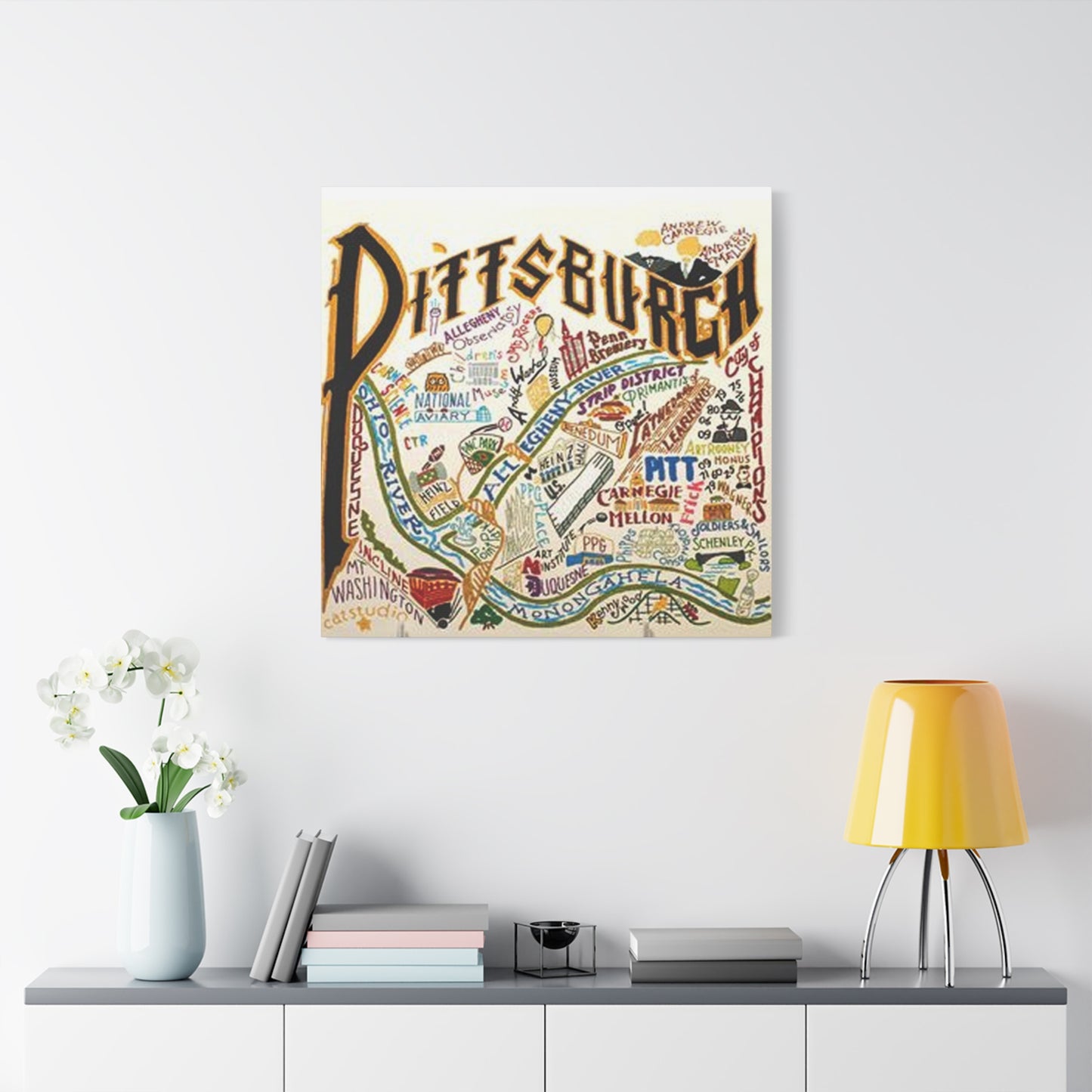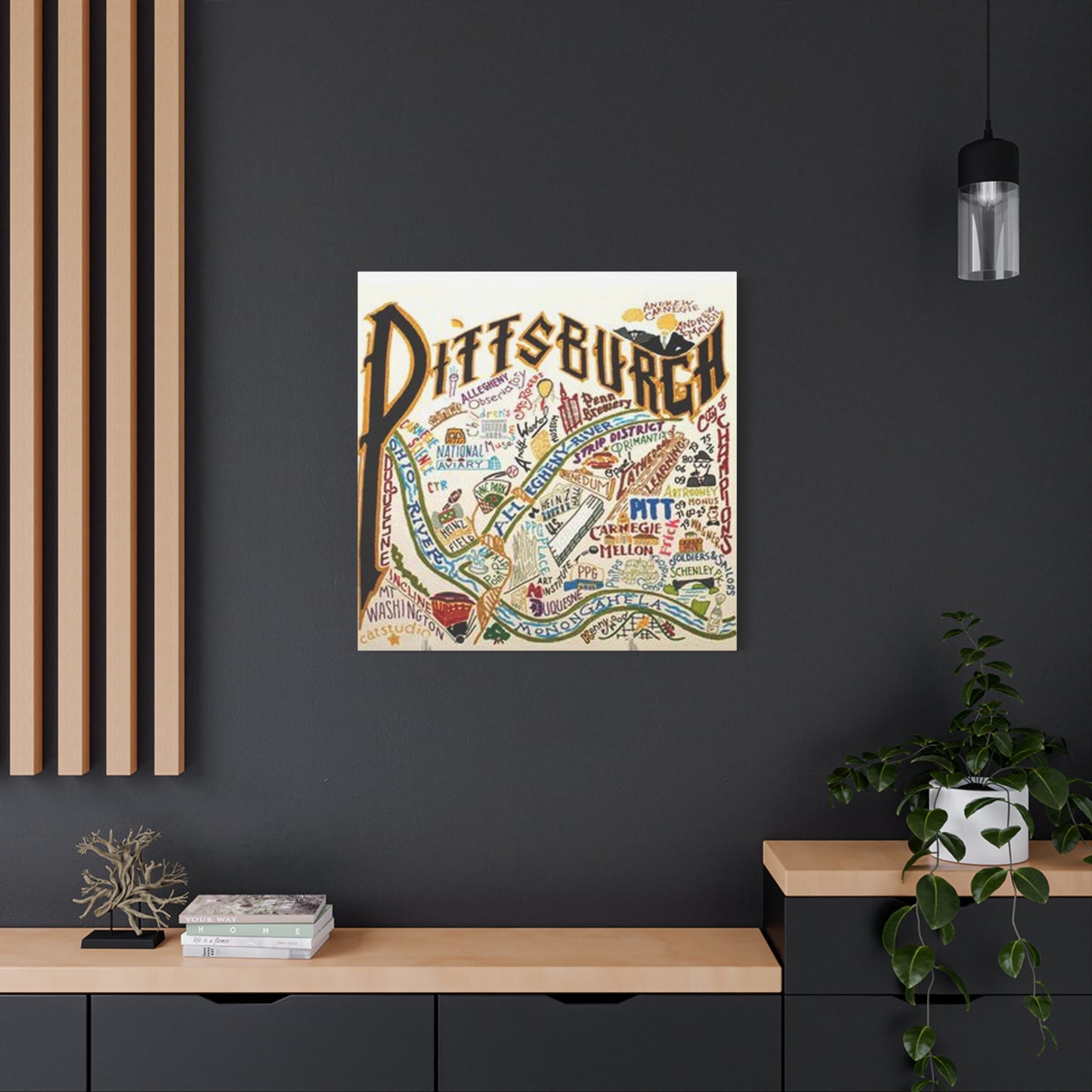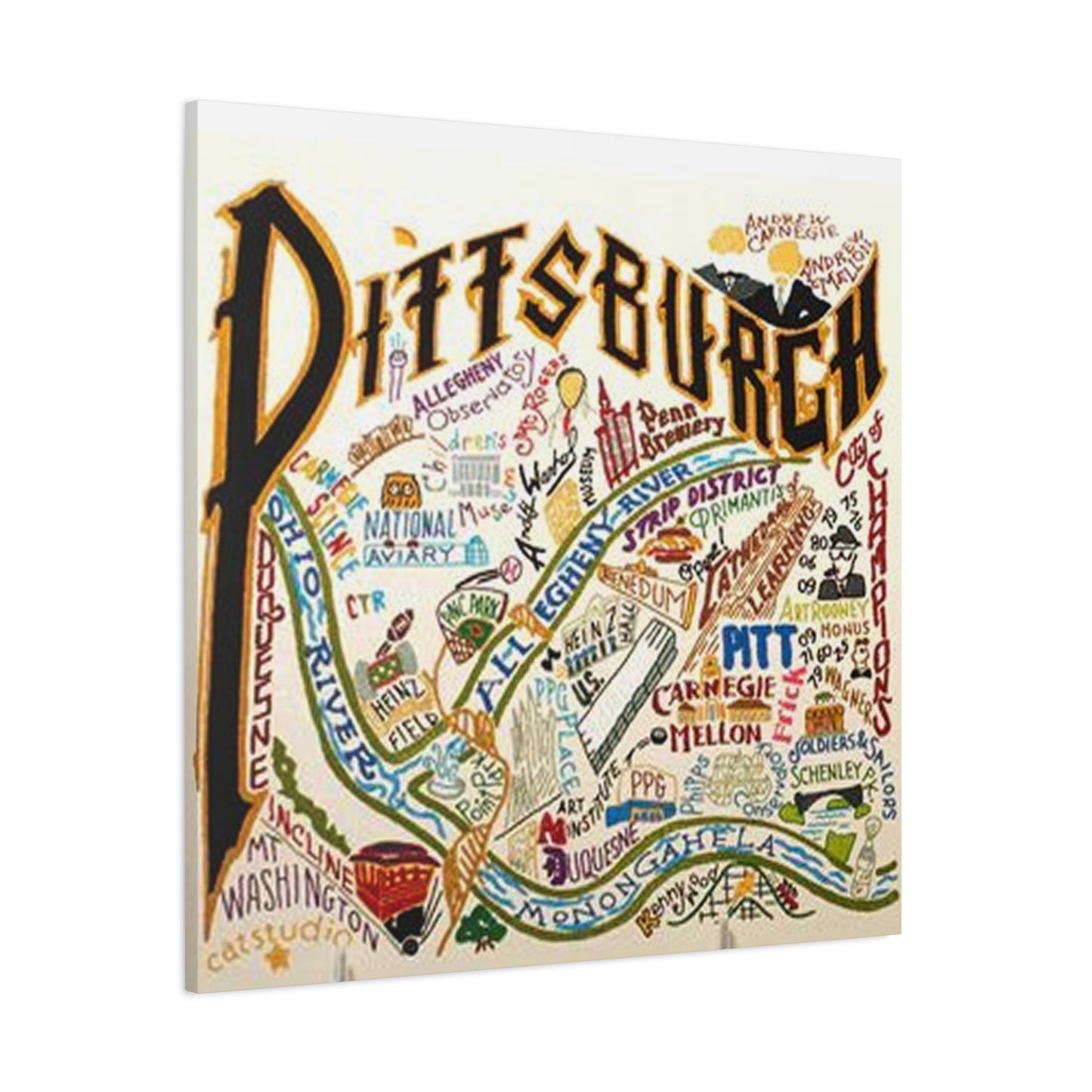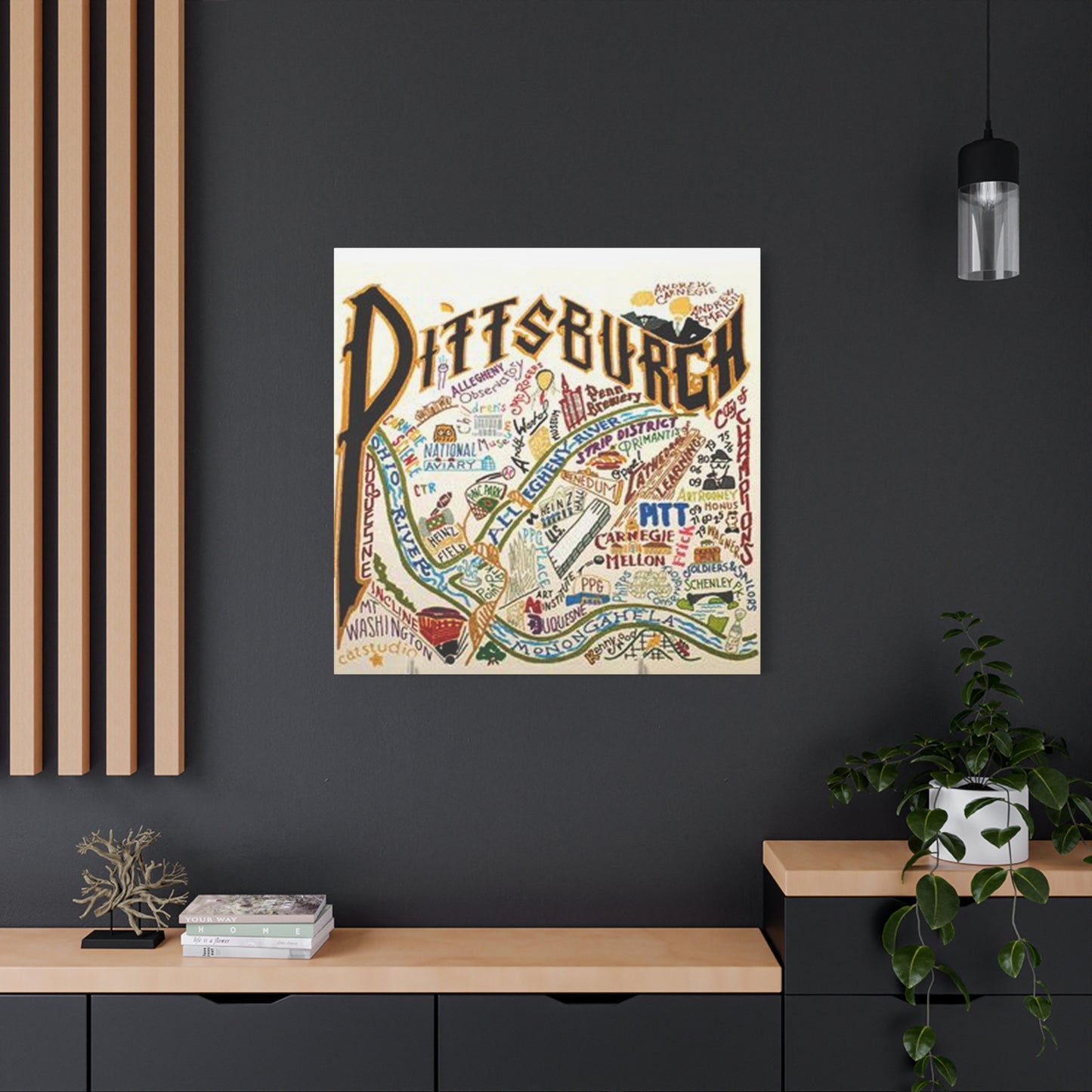Pittsburgh Graffiti Wall Art Prints: A Complete Guide to Urban Street Art Decor
Urban street art has transformed from rebellious expressions on city walls to celebrated forms of artistic decor that capture the raw energy and creative spirit of metropolitan culture. Pittsburgh graffiti wall art canvas prints represent this evolution perfectly, bringing the vibrant aesthetics of street culture into homes, offices, and commercial spaces. These pieces carry the authentic feel of urban landscapes while offering the convenience and sophistication of gallery-quality reproductions.
The appeal of street-inspired artwork lies in its ability to convey emotions, messages, and cultural commentary through bold colors, dynamic compositions, and expressive techniques. When translated onto canvas, these pieces maintain their original energy while becoming more accessible to art enthusiasts who want to incorporate urban aesthetics into their living spaces. The city of Pittsburgh itself has become a significant hub for this art form, with its neighborhoods showcasing remarkable examples of spray-painted murals and stylized lettering that reflect both local culture and broader artistic movements.
Canvas prints featuring urban wall art have become increasingly popular among interior designers, homeowners, and business owners who seek to create spaces with character and authenticity. These reproductions offer several advantages over original street pieces, including durability, portability, and the ability to preserve ephemeral artworks that might otherwise disappear due to weather, building renovations, or city ordinances. The transformation of temporary street expressions into permanent home decor represents a fascinating intersection of underground culture and mainstream appreciation.
Understanding the Cultural Significance of Urban Street Expression
The roots of contemporary spray-painted art trace back to the late 1960s and early 1970s when young artists in Philadelphia and New York began marking their presence on subway trains and building walls. This movement was born from a desire for recognition, territorial marking, and creative expression in communities that felt marginalized or unheard. What started as simple tags and signatures evolved into elaborate murals, complex letter designs, and thought-provoking imagery that challenged traditional notions of what constituted legitimate art.
Pittsburgh developed its own unique street art culture somewhat later than coastal cities, but the movement took root deeply within neighborhoods like Lawrenceville, the Strip District, and Bloomfield. Local artists began using walls, underpasses, and abandoned buildings as canvases for their visions, creating works that reflected the city's industrial heritage, sports culture, working-class identity, and diverse communities. These pieces often incorporated local symbols, historical references, and neighborhood pride, making them distinctly representative of the Steel City's character.
The cultural importance of this art form extends beyond mere decoration. Street murals serve as historical documents that capture specific moments in time, reflecting social movements, political climates, and community concerns. They democratize art by placing it in public spaces where everyone can access and interpret it, regardless of economic status or education. This accessibility has helped street art gain legitimacy as a serious artistic movement worthy of preservation and study.
Many contemporary artists who began their careers painting illegally on city walls have transitioned into gallery exhibitions, commercial commissions, and collaborative projects with municipalities. This evolution demonstrates how street art has moved from the margins to the mainstream while retaining its rebellious spirit and authentic voice. Canvas reproductions play a crucial role in this transition, allowing more people to own and appreciate works inspired by urban expression.
Exploring Different Styles and Techniques in Urban Visual Art
The world of street-inspired artwork encompasses numerous styles, each with distinct characteristics and historical contexts. Wildstyle represents one of the most complex approaches, featuring interlocking letters with arrows, connections, and abstract elements that make the text deliberately difficult to read. This style prioritizes artistic complexity over legibility, showcasing the technical skill and creative vision of the artist. Wildstyle pieces translated to canvas maintain their intricate compositions and dynamic energy, making them fascinating focal points in any space.
Throw-up style takes a different approach, emphasizing speed and bold simplicity. These pieces typically feature bubble letters filled with one or two colors, outlined with a contrasting shade. Originally designed for quick execution to avoid detection, throw-ups have become an aesthetic choice valued for their graphic impact and straightforward visual appeal. Canvas prints featuring this style work particularly well in modern, minimalist interiors where bold statements complement clean lines and uncluttered spaces.
Stencil art represents another significant category within urban visual expression. Artists create intricate designs by cutting patterns into cardboard or plastic, then spray-painting through the openings to create repeated images. This technique allows for precise reproduction and has been used extensively for political messaging and social commentary. The most famous practitioner of this method has created iconic images recognized worldwide, demonstrating how stencil work can achieve both artistic and cultural impact.
Character-based street art focuses on figurative representations rather than letters or abstract designs. These pieces might feature cartoonish figures, realistic portraits, or fantastical creatures integrated into urban landscapes. Character work often carries narrative elements or symbolic meanings, inviting viewers to interpret stories and messages within the imagery. When reproduced on canvas, these pieces bring personality and storytelling elements into interior spaces, creating conversation pieces that engage viewers on multiple levels.
Abstract approaches to street-inspired art break free from representational forms entirely, using colors, shapes, and textures to create purely visual experiences. These pieces might incorporate drips, splatters, geometric patterns, or organic forms that evoke emotions without depicting recognizable subjects. Abstract urban art translates particularly well to canvas, as the emphasis on color relationships and compositional balance aligns with traditional painting principles while maintaining the spontaneous energy of street culture.
The Transformation Process from Street Walls to Canvas Prints
Creating high-quality reproductions of urban wall art requires careful documentation and sophisticated printing techniques. The process typically begins with professional photography of the original work, capturing details, colors, and textures under optimal lighting conditions. Photographers must account for the scale of street pieces, which often span entire building facades, and find angles that present the composition effectively while managing challenges like perspective distortion, uneven surfaces, and environmental conditions.
Digital processing follows the photography stage, where specialists adjust colors, correct distortions, and enhance details to ensure the final print accurately represents the original artwork. This step requires artistic judgment as well as technical skill, balancing faithful reproduction with the practical considerations of translating a large outdoor piece to a smaller indoor format. Color management becomes particularly important, as the pigments used in spray paint behave differently from printing inks, and outdoor lighting differs significantly from indoor illumination.
The actual printing process for premium canvas reproductions utilizes giclée technology, which employs archival-quality inks and high-resolution printing to achieve museum-grade results. Giclée printers use multiple ink cartridges to reproduce a wider color spectrum than standard printers, capturing the vivid hues and subtle gradations characteristic of spray-painted art. The term giclée itself comes from the French word for spray, making it particularly appropriate for reproducing street art aesthetics.
Canvas material selection impacts both the appearance and longevity of the final print. Professional reproductions typically use cotton or polyester canvas with weights ranging from 300 to 400 grams per square meter, providing the texture and substance necessary to support detailed images. The canvas receives special coatings that protect the print surface from moisture, fading, and environmental damage, ensuring the piece maintains its visual impact for decades.
Stretching and mounting the printed canvas requires craftsmanship to ensure the image sits properly on the frame without distortion or sagging. Gallery wrap mounting extends the image around the sides of the frame, creating a finished appearance that requires no additional framing. This presentation method has become standard for urban art reproductions, as it maintains the contemporary aesthetic and allows the piece to hang flush against walls, mimicking how street murals integrate into their architectural contexts.
Creating Gallery Wall Arrangements with Multiple Urban Art Prints
Gallery walls offer opportunities to display collections of urban art prints in curated arrangements that tell visual stories or create thematic environments. Successful gallery walls balance unity and variety, establishing enough consistency to feel intentional while including sufficient diversity to maintain visual interest. Color schemes provide one effective unifying strategy, selecting prints that share palettes even when compositions and styles differ.
Grid arrangements bring order and contemporary sophistication to gallery walls. Equally sized prints hung in precise rows and columns create clean, architectural compositions that work well in modern spaces. This approach suits minimalist interiors and professional environments where visual discipline complements the overall aesthetic. Grid layouts work particularly well with series of related prints or multiple pieces by a single artist, emphasizing the connections between works.
Salon-style arrangements embrace asymmetry and variety, mixing sizes, orientations, and frame styles in organic configurations. This traditional approach creates casual, collected-over-time feelings that suit bohemian, eclectic, and traditional interiors. Salon walls allow for ongoing evolution, making it easy to add pieces or rearrange existing ones without disrupting the overall composition. The informal nature of salon arrangements makes them forgiving of imperfect spacing or alignment.
Horizontal line arrangements establish strong lateral emphasis by aligning the tops, bottoms, or centers of prints in rows. This approach creates visual order while allowing variation in sizes and proportions. Single-row arrangements work well in hallways, above furniture pieces, and in spaces with prominent horizontal architectural features. Multiple-row alignments can fill large walls while maintaining clarity and readability.
Vertical arrangements draw eyes upward and work well in spaces with high ceilings or narrow wall sections. Stacking prints vertically creates elegant, sophisticated compositions that make rooms feel taller. This approach works particularly well flanking doorways, windows, or architectural features, creating balanced symmetry or intentional asymmetry depending on design goals.
Template-based planning tools help visualize arrangements before committing to nail holes. Creating paper templates cut to exact print dimensions allows experimentation with layouts directly on walls using removable tape. Digital planning applications offer similar benefits with less physical effort, allowing virtual arrangement testing and providing precise measurements for hanging. Taking time to plan arrangements carefully prevents costly mistakes and ensures satisfying final results.
Lighting Techniques to Enhance Urban Art Canvas Displays
Proper illumination dramatically impacts how viewers experience canvas prints, influencing color perception, detail visibility, and emotional response. Natural light provides the most pleasing illumination for most artwork but requires management to prevent damage from ultraviolet radiation and heat. Positioning prints away from direct sun exposure protects them while allowing ambient natural light to enhance viewing. UV-filtering window treatments and glazing can reduce harmful radiation while maintaining natural illumination benefits.
Track lighting offers flexible solutions for highlighting individual pieces or entire gallery walls. Adjustable fixtures allow precise aiming and can be repositioned as artwork changes or arrangements evolve. LED track lights provide energy efficiency and produce minimal heat, reducing risk to artwork. The directional nature of track lighting creates dramatic effects with controlled shadows and highlights that add dimension to flat prints.
Picture lights mount directly above or below artwork, providing dedicated illumination that showcases pieces effectively. These fixtures come in various styles from traditional brass designs to minimalist contemporary models, allowing coordination with interior aesthetics. LED picture lights eliminate the heat concerns associated with older incandescent models while providing consistent, color-accurate illumination. The focused nature of picture lights creates distinct visual emphasis, clearly identifying artwork as important focal points.
Recessed ceiling fixtures provide general ambient lighting that can effectively illuminate artwork when properly positioned. Adjustable recessed lights with directional trim allow some aiming capability, helping focus illumination on specific wall areas. This approach works well in rooms with multiple artwork pieces or in spaces where visible fixtures would conflict with design goals. The unobtrusive nature of recessed lighting maintains clean, minimalist aesthetics while providing necessary illumination.
Wall-washing techniques use linear lighting or series of fixtures to create even illumination across entire walls, effectively showcasing multiple pieces simultaneously. This approach works particularly well for gallery walls or collections arranged in rows. Even illumination prevents the competitive hierarchy that can result from individually spotlit pieces, allowing viewers to appreciate the collection as a cohesive whole.
Color temperature affects how colors appear and influences emotional responses to artwork. Warm light between 2700K and 3000K creates cozy, inviting atmospheres and enhances warm colors in artwork while potentially dulling cool tones. Neutral white light around 3500K to 4000K provides balanced illumination that renders most colors accurately without strong warm or cool biases. Cool light above 5000K creates crisp, energetic environments and enhances cool colors but may feel harsh or clinical in residential settings.
Dimming capabilities add versatility to lighting schemes, allowing adjustment of illumination levels to suit different times of day, activities, and moods. Dimmable LED systems maintain consistent color temperature across dimming ranges, unlike some older technologies that shifted toward warmer tones when dimmed. The ability to modify lighting intensity helps optimize viewing conditions for specific pieces while providing general ambient lighting flexibility.
Preservation and Care for Long-Term Quality Maintenance
Environmental conditions significantly impact the longevity of canvas prints. Temperature stability helps prevent material expansion and contraction that can stress canvas fibers and cause premature aging. Maintaining temperatures between 65 and 75 degrees Fahrenheit provides optimal conditions for most canvas materials. Avoiding placement near heating vents, radiators, fireplaces, or exterior walls in extreme climates prevents temperature-related damage.
Humidity control protects canvas from moisture damage that can promote mold growth, material degradation, and loosening from stretcher frames. Relative humidity levels between 40 and 55 percent provide ideal conditions. Dehumidifiers help in damp climates or below-grade spaces, while humidifiers prevent excessive dryness in heated indoor environments or arid regions. Canvas naturally absorbs and releases moisture in response to environmental changes, and extreme fluctuations can cause permanent warping or loosening.
Dust accumulation dulls colors and creates grimy surface buildup that becomes increasingly difficult to remove over time. Regular gentle dusting with soft, clean microfiber cloths or feather dusters prevents significant accumulation. Dusting should proceed gently without pressure to avoid abrading or compressing the canvas surface. For textured canvases, soft natural bristle brushes can reach into surface irregularities more effectively than cloths.
Direct sunlight exposure causes color fading and material deterioration through ultraviolet radiation damage. Even brief daily sun exposure accumulates over months and years, gradually bleaching pigments and weakening canvas fibers. Positioning artwork away from windows or using UV-filtering glazing and window treatments protects prints while allowing natural light in spaces. Rotation of pieces between high-light and low-light locations can distribute exposure across collections.
Cleaning beyond routine dusting requires caution to avoid damaging coatings or printed surfaces. Spot cleaning should use minimally dampened soft cloths with plain water, avoiding chemical cleaners unless specifically recommended by manufacturers. Testing any cleaning approach on inconspicuous edges before treating visible surfaces prevents potentially damaging reactions. For significant soiling or stains, professional conservation services offer expertise and specialized techniques beyond safe at-home approaches.
Structural maintenance involves periodic inspection of stretcher frames and canvas tension. Over time, environmental fluctuations and material aging can cause canvas to loosen on frames, creating surface waviness. Many stretcher frames include expandable corner keys that can be gently tapped to increase tension and restore flat surfaces. This adjustment should proceed carefully with small increments, as over-tightening can damage canvas or create excessive stress at attachment points.
Exploring Pittsburgh's Street Art Heritage and Local Influences
Pittsburgh developed its distinctive urban art culture shaped by the city's industrial history, working-class identity, and diverse immigrant communities. Early examples emerged in neighborhoods experiencing economic transitions as steel industry decline left vacant buildings and underutilized spaces. Artists claimed these canvases to document community stories, celebrate local heritage, and advocate for neighborhood revitalization through creative placemaking strategies.
Lawrenceville established itself as a hub for sanctioned murals and independent artistic expression. The neighborhood's transformation from industrial district to creative community attracted artists who saw walls as opportunities for large-scale expression. Local business owners began commissioning murals to enhance commercial corridors, creating partnerships between property owners and artists that legitimized street art practices. These collaborations produced pieces celebrating neighborhood history, cultural diversity, and contemporary creative energy.
The Strip District's walls showcase bold compositions reflecting the area's commercial vitality and cultural diversity. Market vendors, restaurants, and entertainment venues embrace colorful murals as marketing tools and community contributions. The concentration of foot traffic in this district ensures artwork reaches diverse audiences, from longtime residents to tourists exploring the city's cultural offerings. Pieces in this area often incorporate local food culture, industrial heritage, and celebratory themes.
Bloomfield's Italian heritage appears in street art celebrating the neighborhood's cultural identity. Murals depict historical figures, traditional imagery, and contemporary interpretations of Italian-American experience. These pieces serve community pride functions while attracting visitors interested in ethnic neighborhoods and cultural tourism. The artistic expressions balance heritage preservation with contemporary creative approaches, creating bridges between generations and cultural perspectives.
Downtown areas feature corporate-sponsored murals that bring urban art aesthetics to business districts. These commissioned works typically follow more regulated processes and reflect institutional perspectives alongside artistic visions. While sometimes controversial among street art purists who value independent expression over sanctioned projects, these pieces make urban aesthetics accessible to broader audiences and demonstrate mainstream acceptance of the art form.
Smaller neighborhoods throughout Pittsburgh host individual pieces that reflect hyperlocal concerns, personalities, and stories. These works might commemorate community members, address specific social issues, or simply add color to overlooked spaces. The distributed nature of street art across the city creates ongoing discovery opportunities for residents and visitors who explore beyond established cultural districts.
The Evolution from Illegal Tagging to Recognized Art Form
Early spray-painted markings on city surfaces faced universal condemnation as vandalism representing property destruction and urban decay. Property owners, city officials, and many residents viewed tags and pieces as evidence of social breakdown requiring aggressive enforcement responses. This criminalization created tension between artistic communities and authorities, with artists risking arrest and prosecution while pursuing their creative practices.
The adversarial relationship between writers and authorities became part of the culture, with evading detection considered part of the artistic challenge. Abandoned buildings, rail yards, and highway underpasses became preferred canvases specifically because limited oversight allowed extended work sessions. The illegal nature added excitement and urgency while creating barriers preventing many talented individuals from participating openly in the movement.
Gradual cultural shifts began recognizing artistic merit in some street expressions despite their illegal origins. Gallery exhibitions featuring urban art aesthetics introduced pieces to audiences who would never encounter work in street contexts. Collectors began acquiring paintings and prints from artists known for street work, creating economic incentives for continued creative development. Media coverage evolved from purely negative reporting toward more nuanced perspectives acknowledging artistic dimensions alongside illegal aspects.
Municipal programs emerged offering legal wall spaces where artists could work without criminal consequences. These sanctioned areas allowed larger, more elaborate pieces requiring extended creation times. While some in the underground community criticized these developments as coopting authentic street culture, many artists appreciated opportunities for legitimate expression. Legal walls also enabled community engagement projects where artists worked with residents to create pieces reflecting neighborhood values and aspirations.
The distinction between illegal tagging and sanctioned murals remains significant but increasingly blurred. Many contemporary urban artists maintain practices spanning both legal commissions and unsanctioned pieces, viewing each context as offering different creative opportunities. Public perception increasingly distinguishes between simple tags considered vandalism and elaborate artistic pieces recognized as community enhancements, though legal frameworks don't always reflect these nuanced perspectives.
Commercial Applications in Business and Office Environments
Retail spaces utilize urban art to establish brand identities aligned with youth culture, creativity, and contemporary trends. Clothing stores targeting young demographics particularly benefit from street-inspired aesthetics that resonate with customer values and lifestyle aspirations. The edgy, authentic character of urban art helps brands differentiate themselves in competitive markets while creating Instagram-worthy environments that encourage social media sharing and organic marketing.
Restaurants and bars incorporate street art to create distinctive atmospheres that enhance dining experiences. Urban aesthetics communicate casual, unpretentious character while maintaining visual interest and sophistication. The bold colors and dynamic compositions energize spaces, supporting social activities and extended visits. Neighborhood establishments often commission local artists to create custom pieces that strengthen community connections while supporting the local creative economy.
Office environments increasingly embrace urban art as companies recognize impacts of workplace aesthetics on employee satisfaction and productivity. Creative industries particularly benefit from environments that inspire innovation and signal creative values. The presence of bold, unconventional art communicates that companies value creative thinking and individual expression, potentially attracting and retaining talented employees who prioritize workplace culture alongside compensation.
Hotels and hospitality venues use urban art to create memorable, distinctive environments that differentiate properties in competitive markets. Boutique hotels particularly leverage street art aesthetics to appeal to travelers seeking authentic, locally-connected experiences rather than standardized corporate environments. Lobbies, hallways, and public spaces decorated with urban-inspired prints create visual interest and provide context-specific character.
Healthcare facilities represent surprising contexts where urban art finds application. Pediatric departments use colorful, energetic pieces to create welcoming environments that reduce anxiety for young patients. Mental health facilities incorporate expressive artwork that validates emotional experiences and stimulates positive engagement. The humanizing effect of distinctive art helps counteract the institutional character that can make medical environments feel cold or threatening.
Educational institutions from elementary schools through universities use urban art to create engaging learning environments. Art programs naturally embrace pieces that demonstrate contemporary artistic movements and techniques. Student lounges and recreational spaces benefit from energetic aesthetics that support social interaction and creative thinking. Campus buildings decorated with local street art create connections between institutions and surrounding communities.
Investment Considerations and Value Assessment for Art Collectors
Limited edition prints offer collectibility advantages over unlimited reproductions. Artists and publishers create editions with specific maximum numbers, individually numbering and signing each print. These limited editions appreciate in value as editions sell out and secondary market demand develops. Collectors should verify edition details including total number produced, whether the edition is closed, and documentation proving authenticity.
Artist reputation significantly influences both initial pricing and long-term value potential. Works by established artists with gallery representation, museum exhibitions, and strong market presence command higher prices reflecting proven track records. Emerging artists offer more affordable entry points with potential for significant appreciation if careers develop successfully. Researching artist backgrounds, exhibition histories, and market performance helps assess reasonable pricing and investment potential.
Print quality affects both immediate satisfaction and long-term value retention. Museum-grade archival materials and printing techniques produce pieces that maintain color and structural integrity for decades or centuries with proper care. Lower-quality reproductions may fade, discolor, or degrade relatively quickly, losing aesthetic and monetary value. Investment-grade pieces should include documentation of materials and processes used, certifying archival quality standards.
Provenance documentation establishes authenticity and ownership history, critical factors for significant artworks. Certificates of authenticity from artists or authorized publishers, purchase receipts from reputable galleries, and records of exhibition history all contribute to provenance. Maintaining thorough documentation from initial purchase protects investment value and facilitates future sales should collectors choose to divest pieces.
Market trends influence values as collective taste shifts and specific artists or styles gain or lose popularity. Following art market publications, auction results, and gallery pricing provides insight into current trends. However, true collectors balance investment considerations with personal aesthetic preferences, recognizing that living with artwork provides ongoing enjoyment regardless of market fluctuations.
Customization Options for Personalized Urban Art Experiences
Custom printing services allow individuals to commission reproductions of specific street art pieces they've photographed or discovered. This personalization creates unique pieces unavailable through standard commercial offerings. Customers provide high-resolution images, and print services produce canvas reproductions in desired sizes. This approach appeals to individuals who've traveled and want to preserve memories of encountered artwork or locals who've discovered pieces in their cities.
Size customization ensures artwork fits specific spaces perfectly. Rather than adapting spaces to available print sizes, custom services produce pieces in exact dimensions required. This flexibility proves particularly valuable for challenging spaces like narrow hallways, above-door areas, or architectural features with unusual proportions. Custom sizing eliminates compromises that can undermine design visions.
Color modification services adjust hues, saturation, or contrast to coordinate with interior design schemes. While purists may object to altering artists' original color choices, practical decorating sometimes benefits from modifications ensuring pieces work harmoniously with existing elements. Professional color adjustments maintain artistic integrity while enhancing compatibility with specific environments.
Text personalization allows addition of names, dates, quotes, or other elements creating commemorative pieces or unique gifts. Urban art's relationship with lettering makes text additions natural extensions of the aesthetic. Custom text transforms generic prints into personalized items marking special occasions, expressing individual values, or creating one-of-a-kind decorative objects.
Framing customization offers alternatives to standard gallery wrapping. Traditional frames with matting can formalize urban art for traditional interiors or professional contexts where conventional presentation suits overall design approaches. Float mounting creates dramatic shadow effects that add dimension. Unconventional framing using reclaimed materials, industrial elements, or painted finishes can enhance urban aesthetics while providing protection and finished appearances.
Digital Technology's Impact on Urban Art Reproduction and Distribution
High-resolution photography enables documentation and reproduction of street art that would otherwise remain inaccessible to most audiences. Professional photographers capture pieces from around the world, creating archives that preserve ephemeral works and make them available for printing. This documentation serves both artistic and historical preservation functions, ensuring significant pieces survive beyond their physical existence on streets.
Online marketplaces democratize access to urban art prints, connecting artists and publishers with global audiences. Customers browse extensive catalogs from home, comparing styles, prices, and sizes without geographical limitations. This accessibility expands the market for urban
Retry
S
Continue
art reproductions while allowing smaller artists and independent publishers to reach audiences that would be impossible through traditional brick-and-mortar galleries alone.
Digital printing technology continues advancing, producing increasingly accurate color reproduction and finer detail capture. Modern printers achieve resolutions exceeding what human eyes can distinguish at normal viewing distances, ensuring prints capture every nuance of original works. Expanded color gamuts allow reproduction of the intense, saturated hues characteristic of spray paint, which historically challenged printing technologies designed for more conventional color ranges.
Augmented reality applications now allow customers to visualize how prints will appear in their actual spaces before purchasing. Users photograph their walls and digitally place artwork at scale, seeing exactly how pieces will look with existing furniture, lighting, and architectural features. This technology reduces purchasing uncertainty and returns, benefiting both customers and sellers while ensuring more satisfying final results.
Print-on-demand services eliminate inventory requirements, allowing artists to offer extensive catalogs without financial risk of unsold stock. Customers order specific pieces, which are then printed and shipped directly. This model enables emerging artists to enter the market without significant capital investment while allowing established artists to offer diverse selections without storage and inventory management burdens.
Social media platforms function as discovery tools where artists share work and connect directly with potential customers. Visual platforms particularly suit urban art's photogenic qualities, allowing pieces to circulate widely and rapidly. Artists build followings, receive commissions, and drive traffic to print shops through strategic social media presence. This direct connection between creators and audiences disrupts traditional gallery gatekeeping systems.
Blockchain technology and digital certificates of authenticity address concerns about unauthorized reproductions and edition verification. Some publishers now register limited editions on blockchain, creating permanent, tamper-proof records of edition sizes, individual print numbers, and ownership chains. This technology brings transparency and security to art markets that historically operated on trust and paper documentation vulnerable to fraud.
Legal and Ethical Considerations When Reproducing Street Art
Copyright law protects artistic expression, including unauthorized street art created illegally. Artists retain copyright ownership regardless of whether their work appears on walls they own or have permission to paint. This creates legal complications when individuals photograph and reproduce street art without artist consent. Technically, creating and selling reproductions without permission constitutes copyright infringement exposing violators to legal action.
Practical enforcement challenges mean many unauthorized reproductions occur without legal consequences. Street artists working anonymously or pseudonymously face difficulties pursuing copyright claims. The illegal nature of some work complicates artists' willingness to assert legal rights in court. Many artists accept unauthorized reproduction as inevitable aspects of creating public art, focusing energy on sanctioned income sources rather than pursuing infringement cases.
Moral rights doctrines in some jurisdictions grant artists control over how their works are used regardless of copyright ownership transfers. These rights prevent distortion, modification, or use in contexts damaging to artists' reputations. However, moral rights protections vary significantly between countries and often don't apply to reproductions for private use. Understanding applicable laws requires consulting legal expertise in relevant jurisdictions.
Fair use doctrine in United States copyright law permits some unauthorized uses for purposes like commentary, criticism, education, or news reporting. However, creating decorative reproductions for personal use or commercial sale generally doesn't qualify as fair use. The transformative use consideration examines whether new works add meaning or message rather than simply reproducing originals. Decorative prints typically fail this test, lacking transformative purpose.
Ethical considerations extend beyond legal requirements. Artists invest time, skill, and often personal risk creating street art. Reproducing work without permission and especially without credit or compensation exploits artists while potentially undermining their income from legitimate print sales. Ethically conscious individuals seek permissions, provide attribution, and when possible, purchase prints through authorized channels that compensate creators.
Licensing arrangements allow legal reproduction while compensating artists. Some street artists establish print licensing programs authorizing manufacturers to produce reproductions in exchange for royalties. These arrangements benefit all parties, providing artists income while giving manufacturers legal certainty and quality control. Consumers purchasing licensed prints support artists directly while obtaining authentic reproductions with quality guarantees.
Photographing street art for personal documentation generally falls within acceptable use norms. Sharing photographs on social media with proper attribution similarly aligns with community practices, helping promote artists and their work. However, commercial exploitation including selling prints crosses ethical lines without proper authorization. The distinction between appreciation and exploitation guides ethically sound decision-making.
Understanding the Connection Between Music Culture and Visual Street Expression
Hip-hop culture birthed and nurtured street art as one of its four foundational elements alongside rapping, DJing, and breakdancing. The cultural movement emerging from the Bronx in the 1970s used multiple creative forms to express identity, claim space, and build community. Visual artists developed styles paralleling musical innovations, with tags functioning like artist names and elaborate pieces resembling album covers or stage productions.
The aesthetic connections between hip-hop music and street art appear in shared preferences for bold colors, complex layering, and technically impressive execution. Just as DJs manipulated records to create new sounds, visual artists manipulated letterforms to create new visual languages. The competitive nature of both forms drove innovation as artists pushed boundaries trying to develop unique styles that would earn recognition from peers and audiences.
Punk rock culture embraced street art aesthetics for album artwork, flyers, and venue decoration. The DIY ethos and anti-establishment attitudes aligned perfectly with illegal art production rejecting traditional gallery systems. Stencil techniques particularly connected with punk scenes, offering quick, reproducible methods for spreading messages and imagery. The raw, aggressive visual qualities matched punk's musical characteristics.
Electronic music scenes from rave culture through contemporary EDM embrace street art aesthetics in event promotion and venue decoration. The psychedelic colors, abstract forms, and energetic compositions mirror electronic music's sonic qualities. Music festivals often commission street artists to create installations and murals, recognizing the complementary relationship between visual and musical experiences. These collaborations expose both art forms to each other's audiences.
Jazz and street art share improvisational qualities and emphasis on individual style within established traditions. Both forms balance technical mastery with spontaneous creativity, requiring artists to internalize fundamentals thoroughly enough to execute freely without conscious technical focus. The African-American cultural roots of both jazz and hip-hop create historical connections that influence how street art develops and is understood culturally.
Contemporary popular music across genres incorporates street art aesthetics in music videos, album covers, and stage designs. The visual vocabulary developed on streets has become mainstream commercial language used to convey authenticity, edge, and youth culture connection. Artists from diverse musical backgrounds collaborate with street artists, recognizing the cultural cache and visual impact these aesthetics bring to musical branding.
Regional Variations in American Urban Art Styles and Influences
New York City established foundational styles that influenced street art globally. The subway system's role as canvas created particular aesthetic demands favoring bold, readable compositions visible from moving trains. Letter styles developed in New York spread worldwide as artists traveled or shared photographs. The city's competitive environment drove rapid style evolution as artists constantly innovated to stand out among thousands of practitioners.
Los Angeles developed distinctive approaches influenced by Chicano cultural traditions, car culture, and West Coast lifestyle. Elaborate Old English lettering, figurative murals depicting community themes, and incorporation of lowrider aesthetics distinguished LA work from East Coast styles. The city's sprawl and car-dependent culture meant pieces often addressed automobile speeds rather than pedestrian viewing, influencing scale and simplicity.
San Francisco's street art reflects the city's countercultural history and progressive political culture. Mission District murals address social justice themes, celebrate cultural diversity, and advocate for community causes. The city's acceptance of public art creates environments where street expression functions as legitimate cultural contribution rather than criminal activity. This permissiveness allows more contemplative, message-driven work compared to cities with aggressive enforcement.
Philadelphia claims early development of spray-painted lettering predating New York's subway era. The city maintains active street art scenes particularly in neighborhoods like Fishtown and Northern Liberties. Philadelphia's Mural Arts Program represents one of the most extensive public art initiatives nationally, commissioning thousands of community-focused pieces that blur lines between street art and official public art.
Miami's street art exploded with Art Basel and Wynwood Walls transforming former industrial areas into outdoor galleries. The city's Latin American cultural connections influence aesthetics incorporating tropical colors, cultural imagery, and Spanish language elements. Miami's international art market presence creates unusual opportunities for street artists to transition into gallery representation and commercial success.
Chicago's street art reflects the city's industrial character and neighborhood cultures. Pilsen's murals celebrate Mexican heritage while addressing gentrification concerns. The city's extreme climate challenges outdoor artwork, requiring techniques and materials withstanding harsh winters. Chicago artists often emphasize durability and weather resistance alongside aesthetic considerations.
Seasonal Decorating Strategies Using Interchangeable Urban Art
Rotating artwork seasonally refreshes interior spaces without requiring complete redecorating. This strategy works particularly well with street art's bold, variable aesthetics. Spring rotations might emphasize bright, warm colors and energetic compositions reflecting renewal and growth. Summer selections could feature vibrant, saturated palettes conveying heat and intensity. Autumn pieces might incorporate warmer tones with more contemplative compositions. Winter rotations could employ cool colors or monochromatic schemes reflecting the season's character.
Storage solutions for seasonal artwork require protection from damage while maximizing space efficiency. Acid-free paper or fabric should separate stacked canvases preventing surface abrasion. Climate-controlled storage protects pieces from temperature extremes and humidity fluctuations. Vertical storage racks designed for artwork prevent warping better than horizontal stacking. Proper storage ensures rotated pieces remain in excellent condition ready for future display.
Holiday-specific urban art allows celebration without relying on conventional seasonal decor. Abstract pieces in reds and greens work for winter holidays without explicitly holiday imagery. Orange and black street art suits autumn celebrations while maintaining artistic credibility year-round. This approach accommodates seasonal decorating preferences without surrendering to commercial holiday aesthetics.
Thematic rotations based on personal circumstances rather than calendar seasons offer creative alternatives. Art emphasizing growth and new beginnings might mark life transitions like graduations or career changes. Calming, contemplative pieces could support periods focused on rest and recovery. Energetic, bold selections might accompany phases emphasizing productivity and accomplishment. This personalized approach makes environments responsive to occupants' evolving needs.
The Role of Typography and Lettering in Street Art Compositions
Letter-based compositions form street art's foundational tradition. Early artists claimed urban spaces through tags, stylized signatures that marked territory and built reputations. These simple textual elements evolved into increasingly complex letter designs incorporating three-dimensional effects, interlocking forms, arrows, and decorative elements. The tension between legibility and artistic elaboration defines much letter-based work, with some artists prioritizing readability while others deliberately obscure letters within abstract compositions.
Calligraphic influences appear in street lettering through fluid, gestural marks made with single spray strokes. Artists develop signature motions producing consistent letter characteristics across pieces. The physical nature of spray painting creates natural calligraphic qualities as artists' bodies flow through motions creating marks. This embodied practice connects street lettering to historical calligraphic traditions despite surface differences in tools and contexts.
Block letters provide the foundation for many street lettering styles. These bold, geometric forms communicate directly and work well at large scales. Block lettering's simplicity allows elaborate decorative treatments including patterns, gradients, highlights, and shadows that add dimension without compromising legibility. The straightforward nature of block forms makes them accessible starting points for developing artists while offering enough complexity to challenge experienced practitioners.
Three-dimensional effects add spatial illusion to flat surfaces. Artists use shading, highlighting, and perspective techniques making letters appear to advance from walls or recede into space. These illusions demonstrate technical skill while creating visual drama. Some artists develop signature dimensional approaches becoming recognizable elements of their styles. Three-dimensional lettering translates particularly well to canvas reproductions as the spatial illusions work effectively at any scale.
Message-based street art emphasizes textual content's communicative function. Political statements, social commentary, poetic expressions, and community declarations use letters primarily as vehicles for meaning rather than decorative forms. These text-focused pieces often employ straightforward lettering that prioritizes readability, allowing messages to reach audiences clearly. The directness of approach suits urgent communication goals while maintaining street art's characteristic visual impact through scale, color, and placement.
Mixed typography combines multiple lettering styles within single compositions. Contrasting geometric sans-serif forms with flowing script elements creates visual variety and emphasis hierarchy. This approach allows artists to distinguish words or phrases within messages while creating more complex visual experiences. Mixed typography requires careful balancing preventing compositions from feeling chaotic or unintentional.
Conclusion:
The journey from city walls to home walls represents street art's remarkable cultural evolution. What began as rebellious markings created under cover of darkness has transformed into celebrated artistic expression eagerly incorporated into thoughtfully designed living spaces. Pittsburgh graffiti wall art canvas prints embody this transformation, allowing anyone to access and enjoy the energy, creativity, and cultural significance of urban artistic traditions.
These reproductions serve multiple functions simultaneously. They act as decorative elements that enhance interior aesthetics through bold colors, dynamic compositions, and distinctive styles. They function as cultural artifacts preserving important artistic movements and documenting specific moments in urban creative history. They operate as conversation starters that reveal personal tastes, values, and connections to contemporary culture. Perhaps most importantly, they bring the democratic spirit of street art into private spaces, maintaining the accessibility that defines the movement's ethos.
The technical sophistication of contemporary canvas printing ensures these reproductions honor original artworks while providing practical advantages. Gallery-quality materials and processes produce pieces that rival hand-painted works in visual impact while offering consistency, durability, and affordability impossible with unique originals. The democratization of access this enables allows broader audiences to engage with urban art, expanding appreciation beyond those who can afford original paintings or live near significant street art concentrations.
Selecting and incorporating street-inspired artwork requires thoughtful consideration of multiple factors. Space characteristics, existing design elements, personal preferences, and intended atmospheres all influence optimal choices. The diversity within urban art traditions ensures suitable options exist for virtually any context, from minimalist modern apartments to traditional family homes, from corporate offices to neighborhood restaurants. Understanding the range of available styles, color approaches, and compositional strategies empowers informed decision-making that produces satisfying results.
The maintenance and preservation of canvas prints protects investments while ensuring continued enjoyment. Proper environmental conditions, regular cleaning, appropriate lighting, and careful handling extend lifespan significantly. These relatively simple practices prevent premature degradation, allowing pieces to maintain their visual impact for decades. The longevity achievable with quality reproductions and proper care makes them worthwhile additions to homes and businesses committed to creating lasting, meaningful environments.
Legal and ethical considerations surrounding street art reproduction deserve attention from conscientious consumers. Supporting artists through legitimate channels, respecting copyrights, and providing proper attribution align purchasing decisions with values many street art appreciators hold regarding fairness, community, and cultural respect. The growing availability of licensed reproductions makes ethically sound acquisition increasingly convenient, eliminating the need to choose between desired aesthetics and principled practices.
The psychological and emotional impacts of living with bold, expressive artwork contribute to wellbeing in measurable ways. Visual stimulation maintains cognitive engagement, personal expression through design choices supports identity development, and inspiring environments encourage creativity and positive mood states. These benefits justify investing in artwork beyond its purely decorative functions, recognizing that our surroundings profoundly influence how we think, feel, and interact with others.
Looking forward, the relationship between street art and interior design will likely continue evolving. As urban art gains further mainstream acceptance, new applications and interpretations will emerge. Technological advances in printing and materials will produce even higher quality reproductions with expanded creative possibilities. Digital artists may create works specifically for print reproduction rather than adapting street pieces, blurring lines between different artistic categories.

















